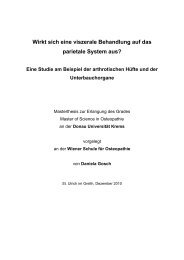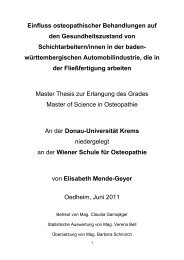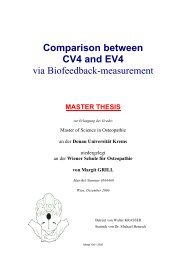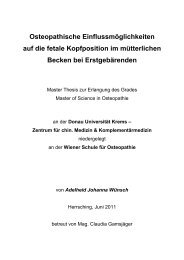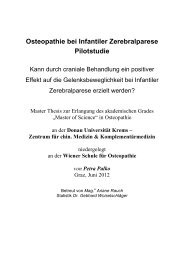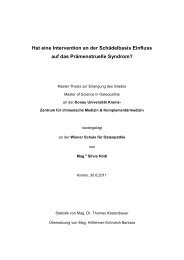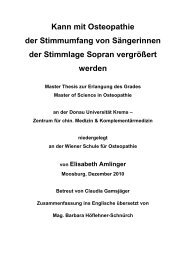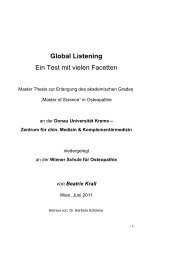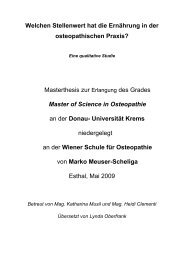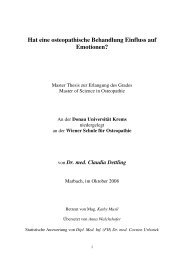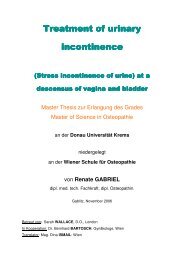Risch Andreas.pdf - Osteopathic Research
Risch Andreas.pdf - Osteopathic Research
Risch Andreas.pdf - Osteopathic Research
Erfolgreiche ePaper selbst erstellen
Machen Sie aus Ihren PDF Publikationen ein blätterbares Flipbook mit unserer einzigartigen Google optimierten e-Paper Software.
Frequent metaphoric expressions in this field were:<br />
HEALTH AS ALLOWANCE, ACCEPTANCE, TOLERANCE, FRAMEWORK,<br />
RESPONSIBILITY,<br />
CONFIDENCE“.<br />
LIMITS, RESPECT, INDIVIDUAL UNDERSTANDING,<br />
The field of „sensing or feeling health“ was mainly dominated by the „OSP“ (Other<br />
Sensory Perception) category followed by the categories „nature“ and „space“ with<br />
very far reaching and philosophical metaphors such as:<br />
HEALTH AS FEELING THAT I DON’T FEEL ANYTHING, AS PERMEABILITY, AS<br />
THE ABILITY OF SWIMMING IN ONES OWN LIQUID, AS PEACE AND HARMONY,<br />
AS COHERENCE, AS SOMETHING WHICH MAKES SENSE, AS FLUCTUATION,<br />
VITALITY, DIMENSION, FULFILMENT”.<br />
9 Discussion<br />
Metaphor analysis originally a research method in cognitive linguistics can prove very<br />
helpful in analyzing osteopathic concepts or conceptualizations of health. By<br />
systematically categorizing and analyzing them according to qualitative research<br />
methods (Schmitt, 2009, Moser, 2000, Heitmann, 2006), metaphors in spoken or<br />
written text can offer access to understanding of abstract terms like health in<br />
osteopathy. Conceptual metaphors are offering insights according to Lakoff and<br />
Johnson (1980) into the supraordinate cognitive concepts which structure our way of<br />
speaking, thinking and acting.<br />
In order to comply with quality criteria of qualitative research the Riemann-Thomann-<br />
Model (2003) was integrated as a method-triangulation, i.e. as a combination of the<br />
metaphoric concepts with other research methods (Flick, 2005), beside the<br />
quantitative and qualitative analysis in order to help categorize the metaphors (e.g.<br />
“association”, “dissociation”, “duration” and “change” in the group of the physical body<br />
experiences). The Riemann-Thomann-Modell (2003) should help to make<br />
categorization of metaphors easier and more transparent. Despite being somewhat<br />
reductionistic, it can serve as a personality model and help to explain the cognitive<br />
concepts of the examined group of people.



